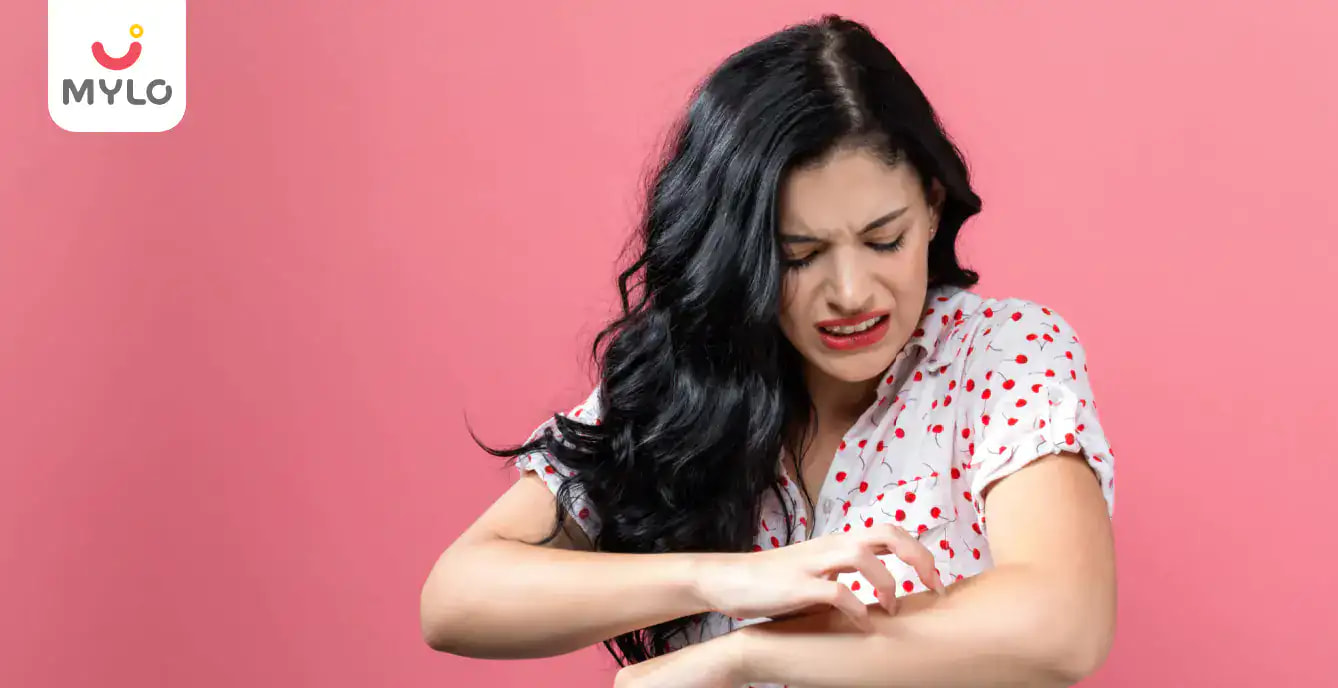Home

Skin Problems

How to get relief from eczema on the skin?
In this Article

Skin Problems
How to get relief from eczema on the skin?
Updated on 3 November 2023
Introduction
Eczema is a skin condition that causes itchiness, dryness, rashes, and other symptoms. There are seven different eczema types, and itchiness is one of the most common eczema symptoms. Eczema treatment is mostly done with the help of medication, but it is important to consult a doctor before administering anything to the eczema skin.
7 Eczema Types
Eczema can look different on different skin tones. It may appear itchy, red, dry, scaly, or thickened on medium to darker skin. On lighter skin, it may appear brown, purple, or ashen. Broadly, there are seven different types of eczema skin.
1. Atopic Eczema
Atopic dermatitis is an eczema type that usually starts in childhood, though it can become milder or go away entirely in adulthood. It is one of three conditions known as the atopic triad, the other two being asthma and hay fever.
2. Contact Dermatitis
There are two common types:
-
Allergic contact dermatitis is when the immune system reacts to an irritant, like latex or metal.
-
Irritant contact dermatitis happens when a chemical or other substance irritates the skin.
3. Dyshidrotic Eczema
Dyshidrotic eczema can cause small blisters on your hands and feet and is more common in women than men.
4. Eczema on Hands
Eczema on the hands may develop if one works with irritating chemicals regularly, like a hairdresser or cleaning person.
5. Neurodermatitis
It is similar to atopic eczema but is more likely to affect adults than children.
6. Nummular Eczema
This causes coin-shaped spots outbreak on the skin.
7. Stasis Dermatitis
Sometimes, weakened veins in the skin may leak out fluids causing this eczema type.
Apart from these common eczema types, there is a lifelong condition called Psoriasis eczema that can cause thickened, red patches of skin and silvery-white scales. These patches can be itchy, sore, and even burning. They commonly appear on the elbows and knees but can also affect the scalp and nails.
Eczema Causes
Many common household items can trigger eczema on face and on other body parts. These include:
-
Certain fabrics and materials
-
Certain soaps and detergents
-
Dust mites
-
Pollen
-
Mold
-
Surface disinfectants
-
Metals like nickel
-
Formaldehyde found in some vaccines and adhesives
-
Natural liquids like those found in fruits and vegetables
-
Scented candles
-
Antibacterial agents like isothiazolinone found in personal care products like baby wipes
-
Chemicals like paraphenylenediamine present in leather dyes
Eczema Symptoms
It is important to remember that eczema skin can present differently for everyone. This means that what works for one person in terms of skincare and treatment may not work for another. Different eczema types may appear on different body parts at different times. Sometimes, people mistake symptoms of psoriasis eczema for eczema, but they are two different conditions.
The most common eczema symptoms are:
-
Itchy skin
-
Dryness
-
Skin inflammation
-
Discolored skin
-
Scaly patches on the skin
-
Oozing or crusting on the skin
-
Swelling on the skin
Eczema Treatment
Eczema can be persistent, requiring different treatment methods over time. Controlling the flare-ups is the most important part of eczema treatment.
Medications for Eczema Treatment
Many different medicated products are available to help control itching and repair the skin. These products have various strengths and formulations, such as creams, gels, and ointments. Whatever the prescribed treatment, it should be administered as directed, usually before applying any moisturizer. Overusing a corticosteroid product can cause side effects such as thinning skin.
Sometimes, antibiotics are also prescribed to control eczema on the hands and face. For more severe eczema symptoms, some options for pills include:
-
Cyclosporine
-
Methotrexate
-
Prednisone
-
Mycophenolate
-
Azathioprine
Still, other options for eczema treatment may include injectables like:
-
Monoclonal antibodies
-
Dupixent
-
Adbry
Therapies for Eczema Treatment
Eczema can be a real pain, both figuratively and literally. It is important to get treatment for it as soon as possible because the sooner it is diagnosed, the easier it is to treat. One way to treat eczema symptoms is by using a corticosteroid ointment, which can be sealed with a wrap of wet gauze.
Light therapy is another way of treating atopic eczema. Phototherapy is the simplest light therapy that exposes the affected areas to natural sunlight but in a controlled manner. Some therapies include narrow band Ultraviolet B (UVB) and artificial Ultraviolet A (UVA).
Eczema skin can thus be treated using myriad ways if the symptoms are diagnosed on time. It is not a scary disease and requires timely attention and care. For more such informative articles, check the Mylo Family blog.
You may also like: https://mylofamily.com/article/top-5-eczema-causes-and-symptoms-188852



Written by
Parul Sachdeva
A globetrotter and a blogger by passion, Parul loves writing content. She has done M.Phil. in Journalism and Mass Communication and worked for more than 25 clients across Globe with a 100% job success rate. She has been associated with websites pertaining to parenting, travel, food, health & fitness and has also created SEO rich content for a variety of topics.
Read MoreGet baby's diet chart, and growth tips

Related Articles
Related Questions
Hello frnds..still no pain...doctor said head fix nhi hua hai..bt vagina me pain hai aur back pain bhi... anyone having same issues??

Kon kon c chije aisi hai jo pregnancy mei gas acidity jalan karti hain... Koi btayega plz bcz mujhe aksar khane ke baad hi samagh aata hai ki is chij se gas acidity jalan ho gyi hai. Please share your knowledge

I am 13 week pregnancy. Anyone having Storione-xt tablet. It better to have morning or night ???

Hlo to be moms....i hv a query...in my 9.5 wk i feel body joint pain like in ankle, knee, wrist, shoulder, toes....pain intensity is high...i cnt sleep....what should i do pls help....cn i cosult my doc.

Influenza and boostrix injection kisiko laga hai kya 8 month pregnancy me and q lagta hai ye plz reply me

Related Topics
RECENTLY PUBLISHED ARTICLES
our most recent articles

Diet & Nutrition
গর্ভাবস্থায় আলুবোখরা: উপকারিতা ও ঝুঁকি | Prunes During Pregnancy: Benefits & Risks in Bengali

Diet & Nutrition
গর্ভাবস্থায় হিং | ঝুঁকি, সুবিধা এবং অন্যান্য চিকিৎসা | Hing During Pregnancy | Risks, Benefits & Other Treatments in Bengali

Women Specific Issues
স্তনের উপর সাদা দাগ: লক্ষণ, কারণ এবং চিকিৎসা | White Spots on Nipple: Causes, Symptoms, and Treatments in Bengali

Diet & Nutrition
গর্ভাবস্থায় পোহা: উপকারিতা, ধরণ এবং রেসিপি | Poha During Pregnancy: Benefits, Types & Recipes in Bengali

Diet & Nutrition
গর্ভাবস্থায় মাছ: উপকারিতা এবং ঝুঁকি | Fish In Pregnancy: Benefits and Risks in Bengali

Diet & Nutrition
গর্ভাবস্থায় রেড ওয়াইন: পার্শ্ব প্রতিক্রিয়া এবং নির্দেশিকা | Red Wine During Pregnancy: Side Effects & Guidelines in Bengali
- ইনার থাই চ্যাফিং: কারণ, উপসর্গ এবং চিকিৎসা | Inner Thigh Chafing: Causes, Symptoms & Treatment in Bengali
- গর্ভাবস্থায় ব্রাউন রাইস: উপকারিতা ও সতর্কতা | Brown Rice During Pregnancy: Benefits & Precautions in Bengali
- Velamentous Cord Insertion - Precautions, Results & Safety
- Unlock the Secret to Flawless Skin: 7 Must-Have Qualities in a Face Serum
- Unlock the Secret to Radiant Skin: How Vitamin C Serum Can Transform Your Complexion
- Gender No Bar: 10 Reasons Why Everyone Needs a Body Lotion
- Unlock the Secret to Radiant Skin How to Choose the Perfect Body Lotion for Your Skin Type
- Top 10 Reasons to Apply a Body Lotion After Every Bath
- Communication in Toddlers: Milestones & Activities
- How to Improve Vocabulary for Toddlers?
- A Comprehensive Guide to Understanding Placenta Accreta
- Vulvovaginitis in Toddlers Causes, Symptoms and Treatment
- A Comprehensive Guide to Understanding Cerebral Palsy in Children
- Bitter Taste in Mouth During Pregnancy: Understanding the Causes and Remedies


AWARDS AND RECOGNITION

Mylo wins Forbes D2C Disruptor award

Mylo wins The Economic Times Promising Brands 2022
AS SEEN IN
















- Mylo Care: Effective and science-backed personal care and wellness solutions for a joyful you.
- Mylo Baby: Science-backed, gentle and effective personal care & hygiene range for your little one.
- Mylo Community: Trusted and empathetic community of 10mn+ parents and experts.
Product Categories
baby carrier | baby soap | baby wipes | stretch marks cream | baby cream | baby shampoo | baby massage oil | baby hair oil | stretch marks oil | baby body wash | baby powder | baby lotion | diaper rash cream | newborn diapers | teether | baby kajal | baby diapers | cloth diapers |








